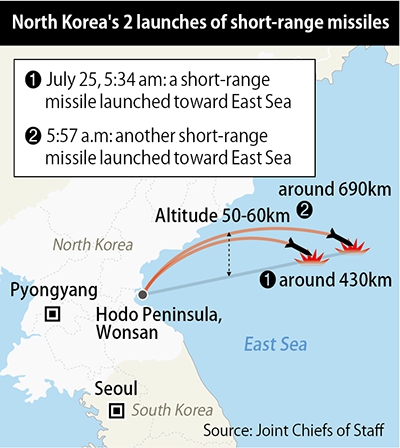Posted on : Jul.26,2019 15:56 KST
Modified on : Jul.26,2019 16:20 KST
 |
|
A new kind of short-range missile launched by North Korea from near Hodo Peninsula in Wonsan, Kangwon Province, on July 25. (Yonhap News)
|
Blue House NSC makes statement on test launch
The two projectiles assumed to be short-range missiles separately test-launched by North Korea toward the East Sea from near Wonsan early in the morning on July 25 represented a “new kind of short-range ballistic missile,” the South Korean government officially confirmed.
Later that day, the Blue House announced that a meeting of the National Security Council standing committee had been convened under Director Chung Eui-yong.
“The standing committee members concluded that the projectiles launched by North Korea this morning represented a new kind of short-range ballistic missile and plan to make a final determination going forward based on a precise assessment with the US,” the Blue House said. It also noted that the standing committee members “expressed strong dismay at this action by North Korea, which is not helpful in efforts to reduce military tensions on the Korean Peninsula.”
 |
|
North Korea‘s 2 launches of short-range missiles
|
Unlike the US and Japanese governments, the South Korean government did not proclaim the short-range missiles launched by North Korea last May to have been “ballistic missiles.” Analysts are suggesting that Seoul is attempting to appear more resolute this time after the controversy caused by its ambivalence, with some claiming that it was attempting to avoid stepping on North Korea’s toes. UN sanctions against North Korea prohibit it from launching ballistic missiles of any form, but the US and other members of the international community have yet to impose any additional sanctions in response to the North Korean short-range ballistic missiles.
At 5:34 am and 5:57 am on July 25, North Korea launched two short-range missiles toward the East Sea from on land near the Hodo Peninsula in Wonsan, Kangwon Province. The Joint Chiefs of Staff (JCS) announced that the two short-range ballistic missiles launched by the North reached an altitude of around 50km and flight distances of around 430 and 690 km, adding that the presence of a transporter erector launcher (TEL) had also been detected.
“This assessment was jointly reached by South Korea and the US, and because it was a new form [in terms of the missile data and launch characteristics], there will need to be additional precision analysis and assessment,” a JCS official said, adding that “South Korea and US intelligence authorities are currently analyzing the detailed data.”
On the question of whether the latest ballistic missiles launched by North Korea were identical to the new model of short-range missile launched in May, a JCS official said, “There will need to be analysis to determine if they’re the same as in May.”
“It’s the first time [observing the missile’s data and characteristics], so there’s a lot to analyze,” the official said.
On May 4, North Korea conducted a launch of a suspected KN-23 missile – the “North Korean Iskander,” with a range of around 240km and altitude of around 60km – from the Wonsan area in Kangwon Province, with leader Kim Jong-un in attendance. Five days later on May 9, it launched suspected Iskander short-range missiles with ranges of 420km and 270km and an altitude of 45–50 km from the Kusong area in North Pyongan Province.
Missiles capable of evading THAAD interception
Ordinarily, short-range missiles have ranges between 300 and 500km and do not travel farther than 1,000km at most; in these cases, altitude amounts to roughly one-quarter of range. The latest suspected short-range missiles launched by North Korea had ranges of around 430 and 690km, while the altitude was around 50km – far lower than with ordinary short-range missiles. In comparison with the short-range missiles launched in May, the altitude was similarly low at around 50km, while the increase of around 270km in the range marked a new development. The Terminal High Altitude Area Defense (THAAD) missile defense system is capable of intercepting missiles at altitudes of 40–150km; once a missile’s altitude drops below 40km, it becomes difficult to target and intercept. While the latest missiles launched by North Korea had altitudes of around 50km, they may be capable of dropping down to below 40km as they approach their target – meaning that they can escape THAAD interception range and engage in evasive maneuvers.
“The Iskander missile is especially difficult to intercept because of changes that occur in the end stage,” explained Kim Dong-yub, a professor at Kyungnam University.
But it remains unclear whether the North Korean short-range missiles were the same ones launched in May with increased ranges, an improved version, or a completely new type of missile. Kim Dong-yub, an expert on military affairs, explained, “With both missiles, there appears to be a strong possibility that they were KN-23s, the North Korean version of the Iskander short-range surface-to-surface ballistic missile.”
“The Iskander’s actual maximum range is over 500km, and has even been calculated at 1,000km. Rather than [North Korea] having produced an additional improved version since the May launch, it appears likely that it wasn’t launched at its maximum range at the time of that launch,” he said, adding that there was “also the possibility that Scud missiles were launched at a low angle.”
The same day, Special Representative for Korean Peninsula Peace and Security Affairs Lee Do-hoon individually spoke by telephone with Stephen Biegun, the US State Department special representative for North Korea, and Kenji Kanasugi, the director-general of the Japanese Foreign Ministry's Asian and Oceanian Affairs Bureau, to share information on the situation and South Korea’s assessment.
By Noh Ji-won, staff reporter, and Hwang Joon-bum, Washington correspondent
Please direct comments or questions to [english@hani.co.kr]










